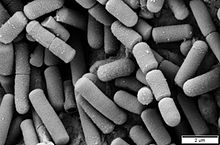| Bacillus cereus | |
|---|---|

| |
| B. cereus colonies on a sheep-blood agar plate | |
| Scientific classification | |
| Domain: | Bacteria |
| Phylum: | Bacillota |
| Class: | Bacilli |
| Order: | Caryophanales |
| Family: | Bacillaceae |
| Genus: | Bacillus |
| Species: | B. cereus
|
| Binomial name | |
| Bacillus cereus Frankland & Frankland 1887
| |
| Biovars | |

Bacillus cereus is a Gram-positive rod-shaped bacterium commonly found in soil, food, and marine sponges.[1] The specific name, cereus, meaning "waxy" in Latin, refers to the appearance of colonies grown on blood agar. Some strains are harmful to humans and cause foodborne illness due to their spore-forming nature, while other strains can be beneficial as probiotics for animals, and even exhibit mutualism with certain plants.[2][3][4] B. cereus bacteria may be aerobes or facultative anaerobes, and like other members of the genus Bacillus, can produce protective endospores. They have a wide range of virulence factors, including phospholipase C, cereulide, sphingomyelinase, metalloproteases, and cytotoxin K, many of which are regulated via quorum sensing.[5][6] B. cereus strains exhibit flagellar motility.[7]
The Bacillus cereus group comprises seven closely related species: B. cereus sensu stricto (referred to herein as B. cereus), B. anthracis, B. thuringiensis, B. mycoides, B. pseudomycoides, and B. cytotoxicus;[8] or as six species in a Bacillus cereus sensu lato: B. weihenstephanensis, B. mycoides, B. pseudomycoides, B. cereus, B. thuringiensis, and B. anthracis.[9] A phylogenomic analysis combined with average nucleotide identity (ANI) analysis revealed that the B. anthracis species also includes strains annotated as B. cereus and B. thuringiensis.[10]
- ^ Paul SI, Rahman MM, Salam MA, Khan MA, Islam MT (15 December 2021). "Identification of marine sponge-associated bacteria of the Saint Martin's island of the Bay of Bengal emphasizing on the prevention of motile Aeromonas septicemia in Labeo rohita". Aquaculture. 545: 737156. doi:10.1016/j.aquaculture.2021.737156.
- ^ Ryan KJ, Ray CG, eds. (2004). Sherris Medical Microbiology (4th ed.). McGraw Hill. ISBN 978-0-8385-8529-0.[page needed]
- ^ Felis GE, Dellaglio F, Torriani S (2009). "Taxonomy of probiotic microorganisms". In Charalampopoulos D, Rastall RA (eds.). Prebiotics and Probiotics Science and Technology. Springer Science & Business Media. p. 627. ISBN 978-0-387-79057-2.
- ^ Cite error: The named reference
Azcón-2010was invoked but never defined (see the help page). - ^ Enosi Tuipulotu D, Mathur A, Ngo C, Man SM (May 2021). "Bacillus cereus: Epidemiology, Virulence Factors, and Host-Pathogen Interactions". Trends in Microbiology. 29 (5): 458–471. doi:10.1016/j.tim.2020.09.003. hdl:1885/219768. PMID 33004259. S2CID 222156441.
- ^ Yossa N, Bell R, Tallent S, Brown E, Binet R, Hammack T (October 2022). "Genomic characterization of Bacillus cereus sensu stricto 3A ES isolated from eye shadow cosmetic products". BMC Microbiology. 22 (1): 240. doi:10.1186/s12866-022-02652-5. PMC 9533521. PMID 36199032.
- ^ Houry A, Briandet R, Aymerich S, Gohar M (April 2010). "Involvement of motility and flagella in Bacillus cereus biofilm formation". Microbiology. 156 (Pt 4): 1009–1018. doi:10.1099/mic.0.034827-0. PMID 20035003.
- ^ Guinebretière MH, Auger S, Galleron N, Contzen M, De Sarrau B, De Buyser ML, et al. (January 2013). "Bacillus cytotoxicus sp. nov. is a novel thermotolerant species of the Bacillus cereus group occasionally associated with food poisoning". International Journal of Systematic and Evolutionary Microbiology. 63 (Pt 1): 31–40. doi:10.1099/ijs.0.030627-0. PMID 22328607. S2CID 2407509.
- ^ Kolstø AB, Tourasse NJ, Økstad OA (2009). "What sets Bacillus anthracis apart from other Bacillus species?". Annual Review of Microbiology. 63 (1). Annual Reviews: 451–476. doi:10.1146/annurev.micro.091208.073255. PMID 19514852.
- ^ Nikolaidis M, Hesketh A, Mossialos D, Iliopoulos I, Oliver SG, Amoutzias GD (August 2022). "A Comparative Analysis of the Core Proteomes within and among the Bacillus subtilis and Bacillus cereus Evolutionary Groups Reveals the Patterns of Lineage- and Species-Specific Adaptations". Microorganisms. 10 (9): 1720. doi:10.3390/microorganisms10091720. PMC 9505155. PMID 36144322.